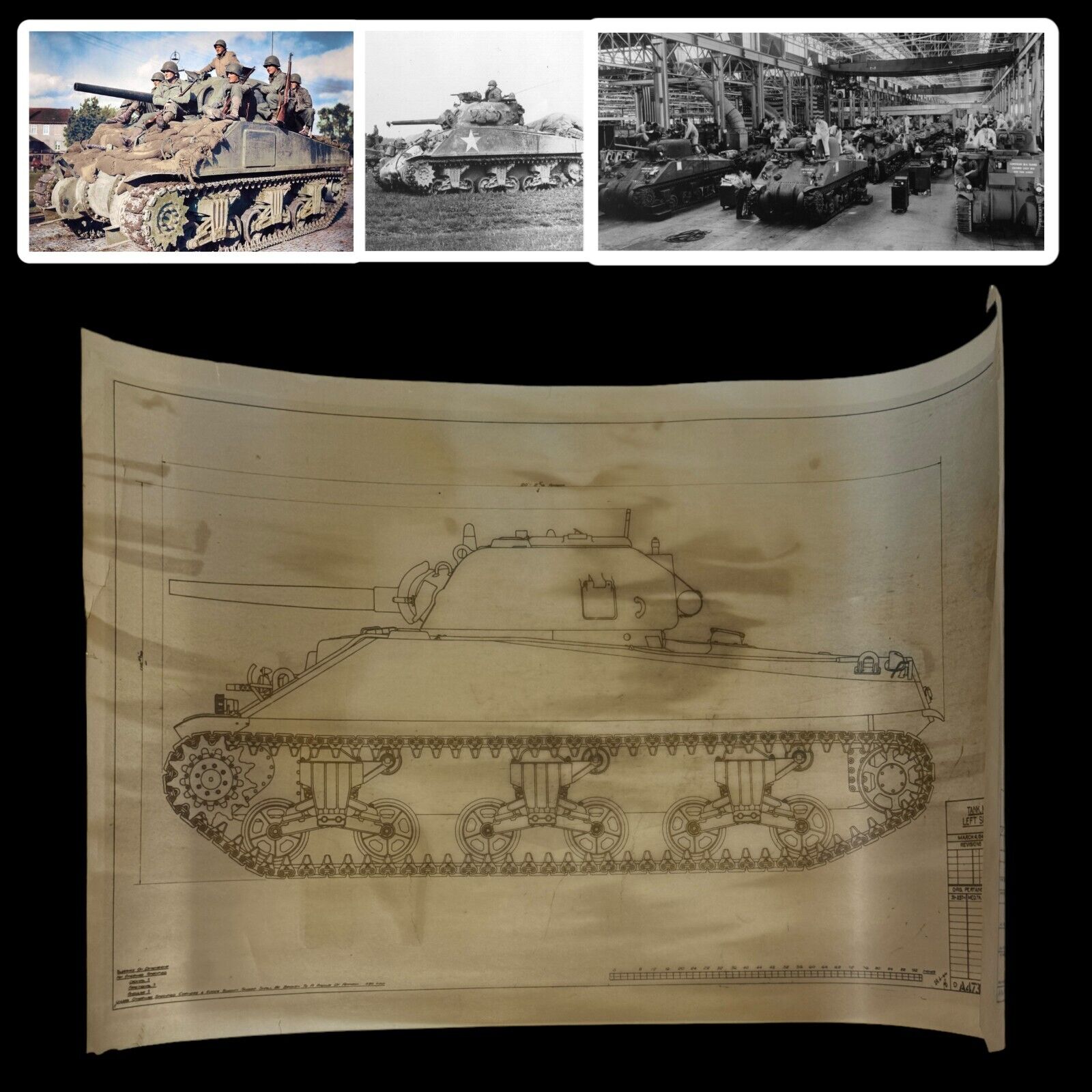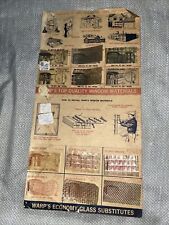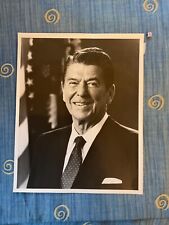RARE Original WWII June 1944 Sherman M4 Medium Tank Ordinance Dept Blueprint For Sale

When you click on links to various merchants on this site and make a purchase, this can result in this site earning a commission. Affiliate programs and affiliations include, but are not limited to, the eBay Partner Network.
RARE Original WWII June 1944 Sherman M4 Medium Tank Ordinance Dept Blueprint:
$12500.00
Comes with a hand-signed C.O.A.
Size: 8 x 14 inches
This extremely rare and museum-grade World War II artifact is an original June 1944 dated “Ordinance Department U.S.A.” blueprint of the infamous Sherman M4 Medium Tank. This original semi-transparent overlay blueprint was created on June 29th, 1944 and was created with updated improvements to the Sherman M4 Medium Tank from the previous Ordinance Dept. revision done on March 4th, 1943.
This is a once-in-a-lifetime chance to own a truly one-of-a-kind artifact from one of the most infamous tanks of World War II. This original Ordinance Dept. blueprint of the M4 Sherman Tank is the only known blueprint that is for sale in the public sector. Only a very small handful of these 1944 M4 Sherman Tank Ordinance Dept. blueprints exist with all being in private museum collections.
The M4 Sherman tank is one of the most iconic armored fighting vehicles of World War II. Named after the American Civil War General William Tecumseh Sherman, the M4 was the workhorse of the Allied armored forces. Its design, production, and combat history reflect both the technological advancements and strategic necessities of the time.
Design and Development
The design of the M4 Sherman tank began in response to the changing dynamics of armored warfare observed in the early years of World War II. By 1940, the German Blitzkrieg tactics had demonstrated the critical need for effective and mobile armored units. The United States recognized the inadequacies of its existing tank models, such as the M2 and M3, and initiated the development of a new medium tank that would eventually become the M4 Sherman.
The primary goals for the Sherman were simplicity, reliability, and ease of mass production. The design incorporated a welded hull to enhance durability and streamline manufacturing. The tank was armed with a 75mm, capable of firing high-expsv. and armor-piercing rounds, making it versatile against both infantry and armored targets. Additionally, the Sherman was equipped with a 50-caliber Browning M2 MG and a 30-caliber Browning M1919A4 MG for secondary armament.
A critical feature of the Sherman was its relatively high speed and maneuverability, attributed to its Continental R975-C1 radial gasoline engine. The suspension system, based on the Vertical Volute Spring Suspension (VVSS), provided a smoother ride over rough terrain. As the war progressed, the Sherman underwent numerous modifications, leading to various sub-models with improvements in armor, armament, and engine performance.
Production
The production of the M4 Sherman tank was a massive industrial effort, emblematic of the United States' wartime manufacturing capabilities. The American automotive industry, with its expertise in mass production, played a pivotal role. Major manufacturers, including the American Locomotive Company, Baldwin Locomotive Works, Detroit Tank Arsenal (operated by Chrysler), and the Ford Motor Company, were involved in the production process.
From 1942 to 1945, over 49,000 Sherman tanks were produced, making it one of the most widely manufactured tanks of the war. This large-scale production was facilitated by the standardization of parts and components, allowing for efficient assembly and repair. The interchangeable parts system also meant that damaged tanks could be quickly repaired in the field using components from other Shermans, ensuring high operational availability.
The production process was highly streamlined. Tank hulls were constructed from rolled homogeneous armor plates, which were welded together to form the body of the tank. The turrets were similarly constructed and equipped with the main gun and secondary armament. Once assembled, the tanks underwent rigorous testing to ensure they met the necessary performance and reliability standards before being shipped to the front lines.
Combat History
The M4 Sherman tank saw extensive combat throughout World War II, serving in numerous theaters and with various Allied forces. Its combat history can be divided into several key phases and notable battles.
North Africa
The Sherman's first significant engagement came in the North African campaign, where it was deployed by the British Eighth Army. The tank's debut at the Second Battle of El Alamein in October 1942 marked a turning point in the campaign. The Sherman's firepower, mobility, and reliability outmatched the older German and Italian tanks, contributing to the eventual Allied victory in North Africa.
Italy
Following the success in North Africa, the Sherman played a crucial role in the Italian campaign. The rugged terrain and fortified positions in Italy posed significant challenges, but the Sherman's versatility and adaptability proved invaluable. It supported infantry assaults, engaged enemy armor, and provided crucial fire support during key operations such as the battles for Monte Cassino and the breakout from the Anzio beachhead.
Western Europe
The Normandy invasion on June 6, 1944, marked the beginning of the Sherman's most extensive combat operations. During the D-Day landings and subsequent battles in France, the Sherman was the backbone of Allied armored forces. Despite being outgunned and out-armored by German Panthers and Tigers, the Sherman compensated with superior numbers, tactical flexibility, and logistical support.
One of the most notable engagements involving the Sherman was the Battle of the Bulge in December 1944. During this last major German offensive, Shermans played a crucial role in repelling the attack and eventually pushing the German forces back across the Rhine River.
Pacific Theater
While less prominent than in Europe, the Sherman also saw action in the Pacific Theater. Modified versions of the M4 were used by the United States Marine Corps in island-hopping campaigns. The Sherman was effective in providing fire support against Japanese fortifications and bunkers, notably in battles such as Iwo Jima and Okinawa.
The M4 Sherman tank was a remarkable feat of wartime engineering and production. Its design emphasized simplicity, reliability, and mass production, which were crucial to its success on the battlefield. Throughout its service in World War II, the Sherman proved to be a versatile and effective combat vehicle, contributing significantly to Allied victories in multiple theaters. Despite its limitations, such as relatively thin armor and less powerful armament compared to some German tanks, the Sherman's sheer numbers, adaptability, and the strategic use of combined arms ensured its place as one of the most important tanks of the Second World War.

Related Items:
Rare Original 1972 “Vote McGovern” Presidential Campaign Poster
$60.00
RARE ORIGINAL VINTAGE ADVERTISING WARP’S TOP QUALITY PLASTIC Material Samples
$39.00
RARE ORIGINAL , Press Photo USA President , RONALD REAGAN , from the usa embassy
$50.74



